Elegoo Saturn 4 Ultra 16K
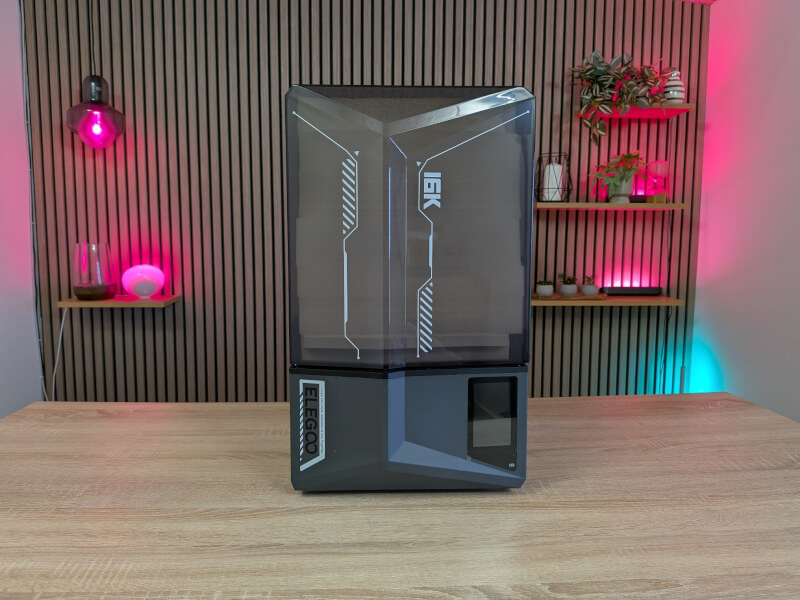
Key Features
- 16K LCD Screen
- Tilt Release Technology For Ultra Fast Printing
- Smart Auto Leveling
- Smart Sensor: Resin Shortage Alert, Foreign Object Detection Alert
- AI Camera: Real-time Monitoring + Time-Lapse Photography
- Build volume of 211.68(L) ×118.37(W) ×220(H) mm
- Resin Tank with Built-in Heater
One of the biggest updates, and in my book by far the best, is that the updated Saturn 4 Ultra now comes with a heated Resin tank. In cold parts of the world, like ours, this can make a big difference.
A tour around the Elegoo Saturn 4 Ultra 16K
If you're familiar with the previous Saturn 4 Ultra, there won't be much difference on the surface. The two machines have exactly the same external dimensions and the same design.
If it weren't for the 16K on the UV shield, you wouldn't be able to tell the two machines apart when they're side by side. So if you've read our review of the regular Saturn 4 Ultra, some of it will sound familiar.
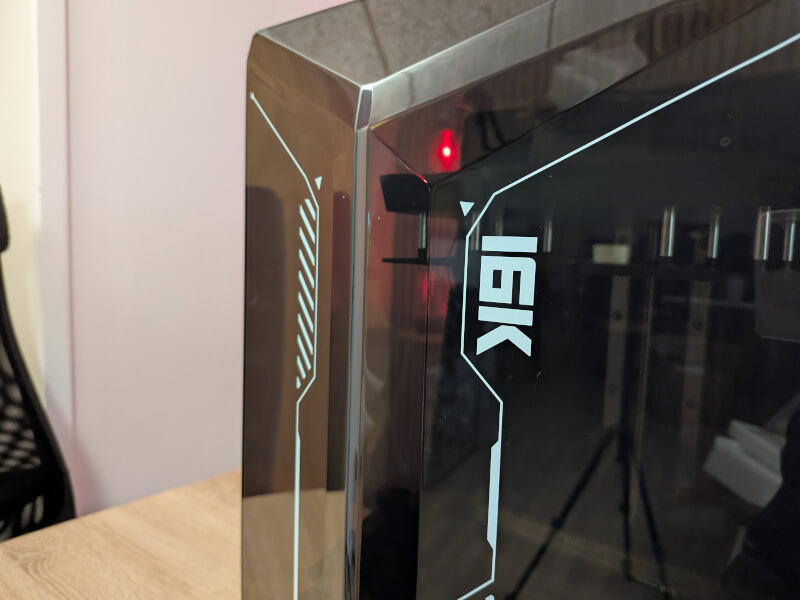
However, there are of course differences on the new machine. Some of them are small and others are quite large.
The design of the Saturn 4 Ultra 16K follows the new design style that we've seen from Elegoo lately. So no more red and black, but instead a, in my opinion, stylish monochrome gray color spiced up with a few graphic elements here and there.
The biggest external difference from previous generations of Saturn machines from Elegoo is the lid. It can now be tilted back and does not have to be lifted completely to get to the machine.
However, this also means that you need a little extra space behind the machine, as the lid folds back here. However, I think it's an incredibly nice detail, as it makes daily operation of the machine easier when you don't have to lift the entire lid off and find a place to put it.
However, I would have liked Elegoo to have made a grip or handle of some kind. As it is now, the lid is virtually impossible to operate with one hand.
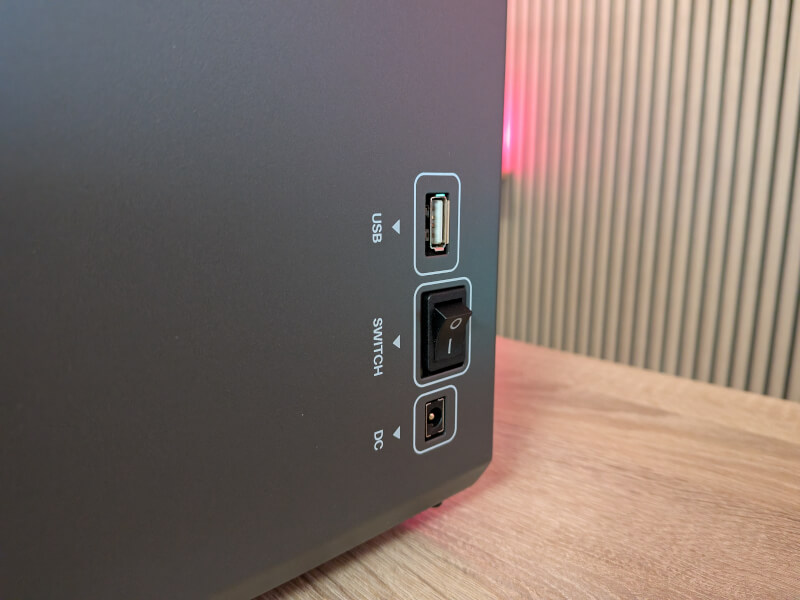
The connections on the machine we find, a bit inconvenient on the back right corner of the machine. Here we also find the first small but good improvement in the new version. We get both a power plug and a USB port. In addition to that, Elegoo has gone away from the external WiFI antenna, which is usually also located here. So now we get a more streamlined machine with an internal WiFi antenna.
Fortunately, the actual operation of the machine is done via a 4” Capacitive Touch Display on the front of the machine. On that front, there is nothing new and the screen is both clear and responsive.
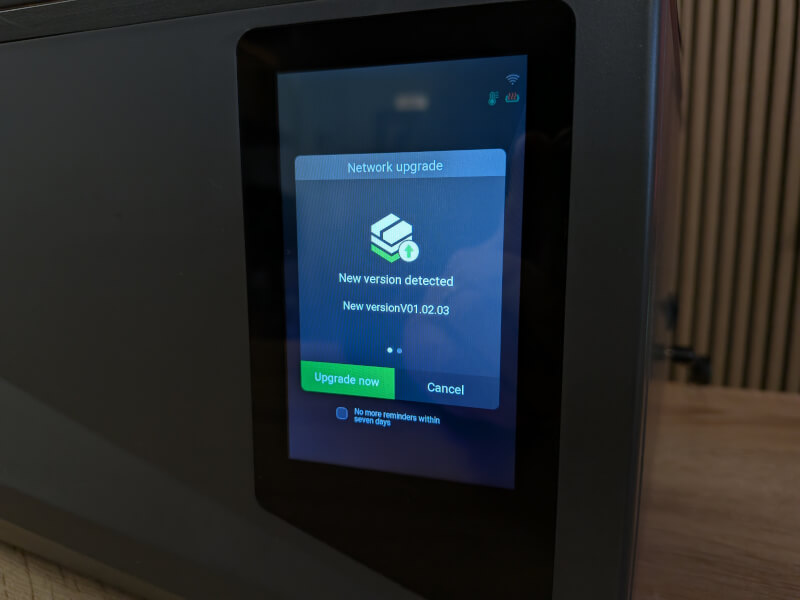
On the back of the machine there is the option to mount a ventilation system. This could be Elegoo's own Mars Mate system or just another ventilation system. An internal air purifier is not included with the Elegoo Saturn 4 Ultra 16K.
Another small detail that is super cool, but definitely not standard on resin 3D Printers, are the adjustable rubber feet. They ensure that the machine stands firmly and they can be adjusted if your surface is not completely level. Simply screw them on to adjust the length so that you have a machine that stands perfectly level.
If we jump into the machine, we find the major updates. The central one is of course the 10” large “16K” mono LCD screen with a resolution of 15120 x 6230. This gives an XY resolution of 14x19μm. On paper, it is a solid update from the previous Saturn 4 Ultra, which had a resolution of 11520x5120 and an XY resolution of 19x24μm.

However, I doubt that it is something that in practice can be seen with the naked eye.
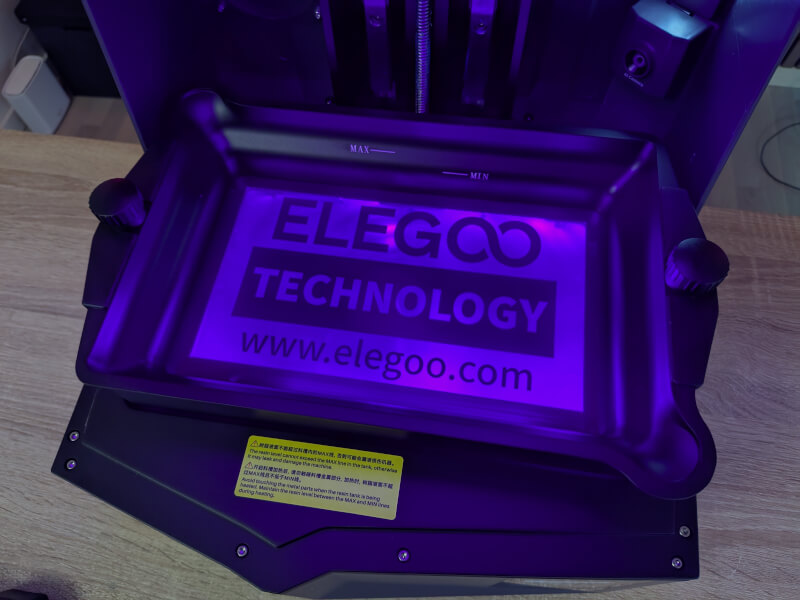
Under the screen, the Saturn 4 Ultra is equipped with a COB UV light source, which together with a Fresnel Collimating lens ensures uniform brightness across the entire print area.
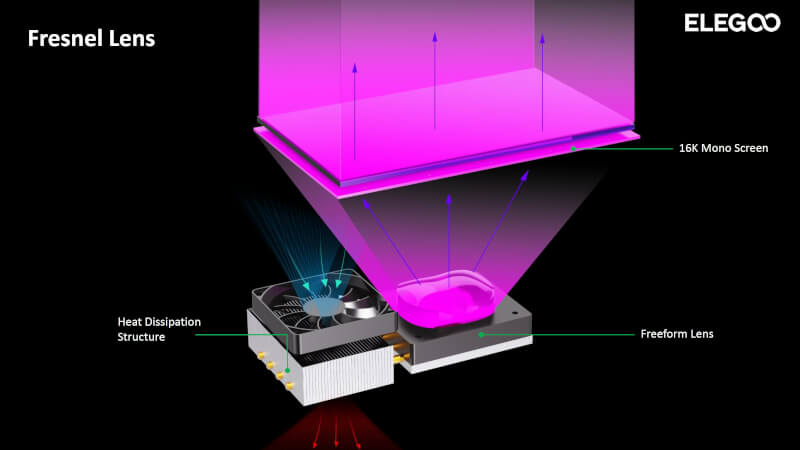
The screen is also central, as it continues to be tied to perhaps the biggest new development from Elegoo, namely the Tilt Release system. It was introduced with the Saturn 4 Ultra and Mars 5 Ultra machines.
In short, it works by tilting the entire screen and resin container between each exposure. This way, the print is released from your build plate with less pulling force on the print. At the same time, this solution also means that you save a lot of time in your prints, as you no longer have to lift the entire build plate part up and down for each exposure.
With the Tilt Release system, the build plate part only needs to be raised a minimal amount, corresponding to your layer height, each time.
On the surface, it is a solution that means you get a machine that can print significantly faster than traditional machines, without the need for special resin types or ACF films.
However, this also means that you now have more moving parts in the machine and thus more potential points of failure. As I mentioned in our test of the Mars 5 Ultra and Saturn 4 Ultra, my biggest concern is that the machine is now effectively open down to the UV light source under the screen. So if you are unlucky and get a hole in your FEP film or spill resin, it can potentially run down into the internal parts of the machine. If this happens while you are printing, in the worst case, you risk the spilled resin being cured by the UV light, and you are left with a dead machine.
In my testing of both the Saturn 4 Ultra and Mars 5 Ultra, however, I have not experienced anything that has given rise to real concern. I am also active in a number of online communities around 3D Printing and Elegoo machines. I have not experienced it described as a major problem by other users of Tilt Release machines.
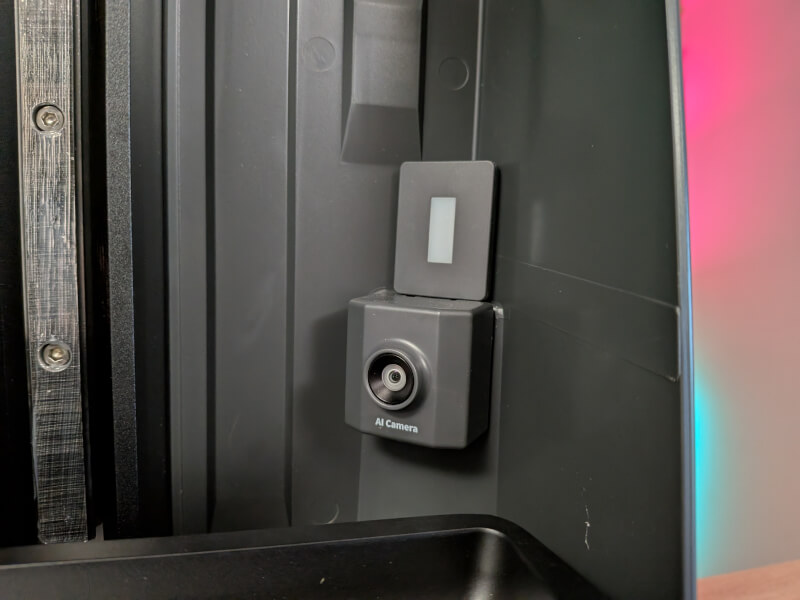
One of the new features in the Saturn 4 Ultra was an AI camera in one corner of the print chamber. It can help detect if you start a print with something on your build plate and should even be able to detect if your print tears off along the way.
Some of these features can help avoid incidents where your FEP film can be punctured, resulting in a resin leak.
In addition to the practical functions, the camera can also be used to live monitor its prints or record timelapse videos.
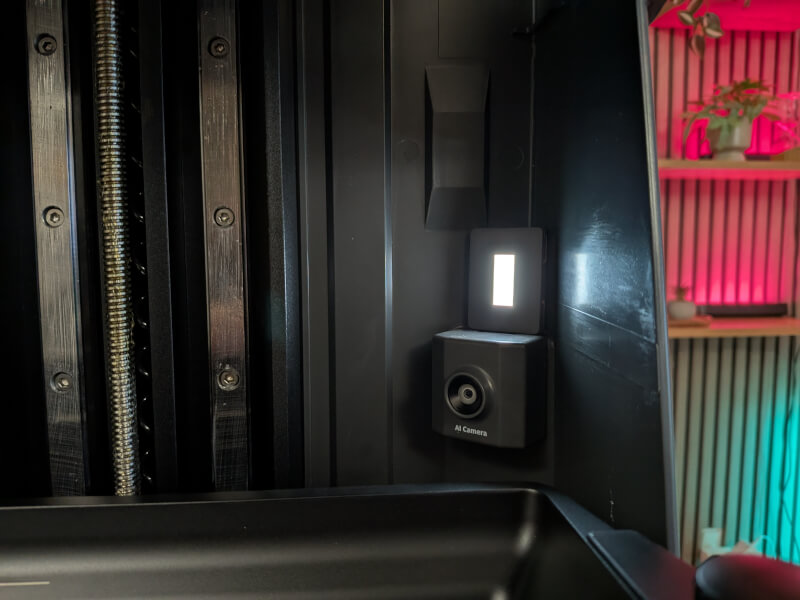
For these purposes, Elegoo has now updated the machine with a light in the chamber. Previously, the built-in camera was quite limited if it was in a dark room, as it would naturally be too dark for the camera to be of much use.
This has now been solved with a strong light, which means that the camera functions can be used much more, and you can now actually get usable Time Lapse videos out of it.
The included build plate for the Saturn 4 Ultra features the same laser-etched surface that has become standard on Elegoo's machines. It is attached with a Quick Release clamp system, which makes it significantly easier to get the plate on and off.
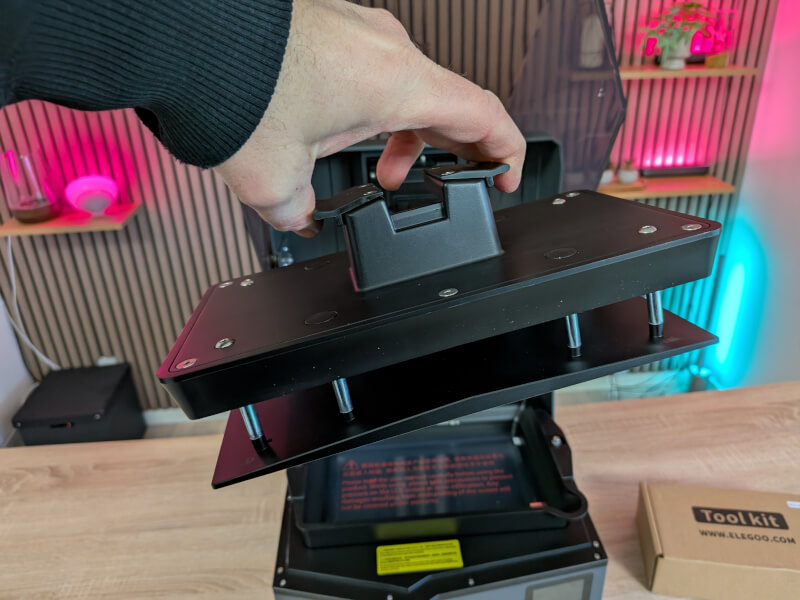
Here too we have a small update, as there are small wings on each side where you hold when removing or putting your build plate in place. It's a small detail, but one that helps to improve the user experience significantly.
The system comes with built-in “auto leveling”, which means you don't have to spend time setting up the machine, but can print right out of the box. It shouldn't be necessary to perform a leveling process.
This is all done using springs in the build plate part, which is also the reason why it looks somewhat different than the build plate solutions we are used to.
However, Elegoo has made it easier to do a manual level process if you need to.
Built into the new build plate are also a series of sensors that measure your resin level, but it should also be able to detect foreign objects in your resin container.
The new resin container is the biggest update to the Saturn 4 Ultra 16K. The immediate design is the same as the previous Saturn 4 Ultra. A pouring spout has been made on both sides of the container to make it easier to pour resin back into the bottle when needed.
The container is a good deal larger than the screen in the Saturn 4 Ultra, which means there can be quite a bit of resin in it. There is room for a full liter in the container at a time, but it is important not to fill it with too much.
There needs to be a bit of an overhang at the top, as there needs to be room for things to tilt without resin spilling over the edge. So it is SUPER important not to fill the container with more resin than the MAX line.
The biggest upgrade, however, is that the resin tank can now heat your resin to an optimal temperature of 25 degrees. Cold environments can have a negative impact on your prints and make it completely impossible to print with certain types of resin. At the same time, the temperature of your resin can also affect how accurately you can tune your resin and settings.
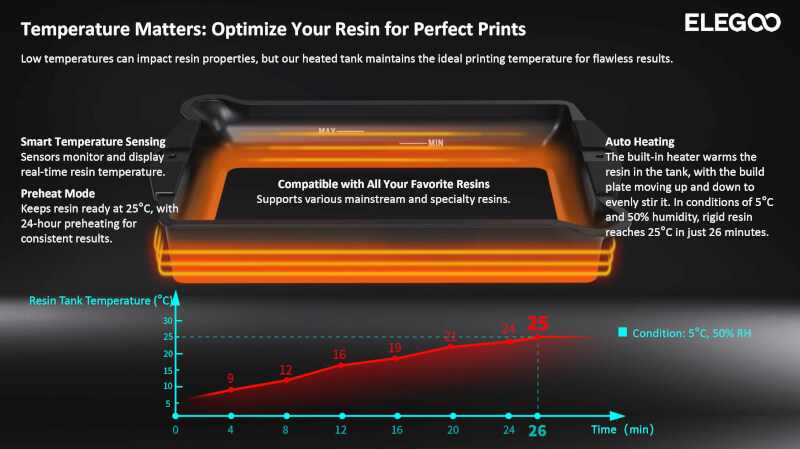
That's why a heated resin tub is a super cool upgrade for users like us in cold parts of the world. It means we now have a stable temperature that is the same every time and removes another variable.
The heated tub is a solution that can only be used on the new Saturn 4 Ultra 16K and cannot be moved to the “old” machine. The power for the heating comes to the resin tub via pogo pins at the bottom of the tub. So just place it in place and there is a connection.

It is an elegant solution that does not require additional cables or anything else.
Also included in the box is a plastic spill tray that you can place around the resin container when removing prints or filling it with resin. It protects the area around the container, so you are better protected against spills and drips that could end up running into the machine via the Tilt Release opening.
Software
The software experience with the Saturn 4 Ultra 16K is divided between the interface on the machine itself and the Chitubox Basic software, which is used to prepare files for printing.
The interface itself on the machine is still super nice and easy to use. It's easy to navigate the new interface and it's quick to set up the machine and connect to WiFi.
When on WiFi, the machine can also automatically check for firmware updates, which was the case in our case.
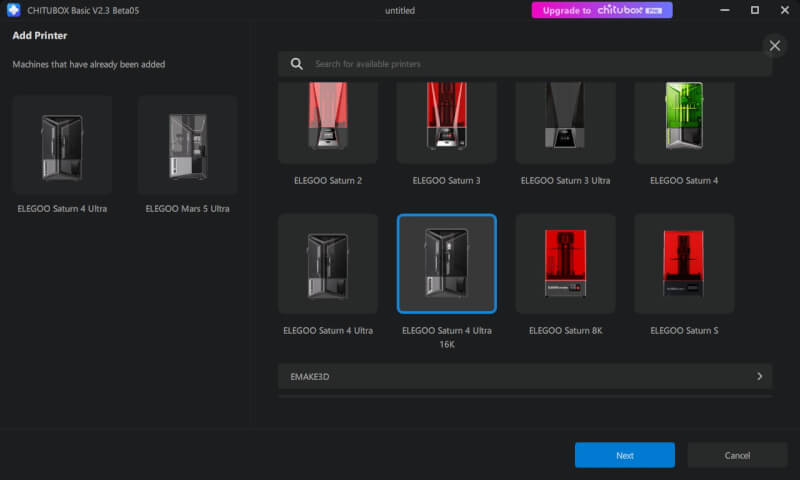
When you start the machine, it goes through an automatic self-test where it calibrates the mechanical sensor, checks the status of parts such as the motor, light source and even keeps track of when it is recommended to change the FEP film.
Once you have started a print, you can easily access information about the print and even change details, such as exposure, etc. along the way if adjustments are needed.
One of the best things about the software is the built-in resin calibration. Here, in fields of four, six or eight with variable exposure times, you can easily tune your exposure time in a quick and easy way.
You can also turn resin heating on or off via the software depending on your needs. Since it is winter and I only have about 13 degrees in the workshop where the printer is tested, I naturally turned it on during my tests of the Elegoo Saturn 4 Ultra 16K.
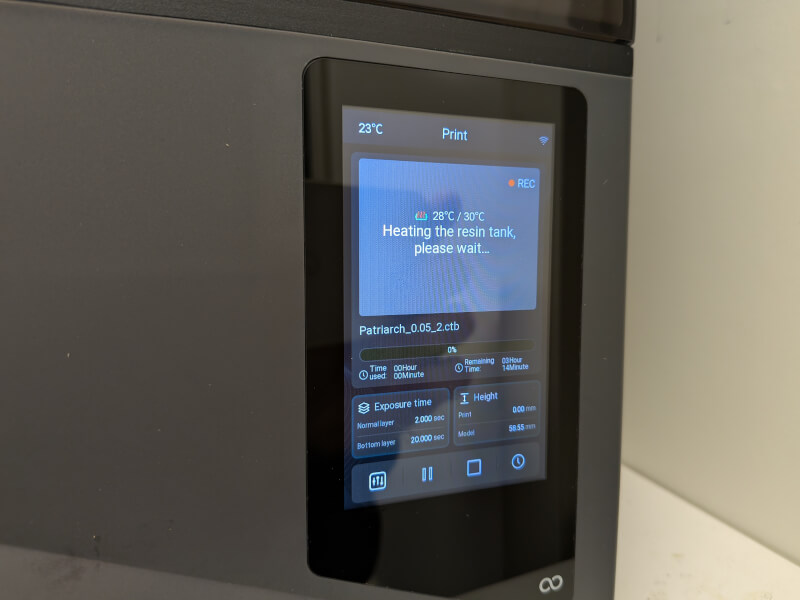
The second part of the software experience is via the Chitu box software, which is used to slice the files for the Elegoo Saturn 4 Ultra 16K. Elegoo has also made their own software in their SateLite slicer. However, it is not fully rolled out yet, so I have stuck with the Chitubox for this test.
It is the new Chitubox Basic version that must be used. Here the software has been given a boost in terms of the interface, but it is in many ways the same as we know it from Chitubox. Elegoo is not the one developing the software, so ultimately the responsibility does not fall entirely on them.
However, the integration was fine and without any problems and there was a print profile ready in the software for the Saturn 4 Ultra 16K machine, so it was ready to go.
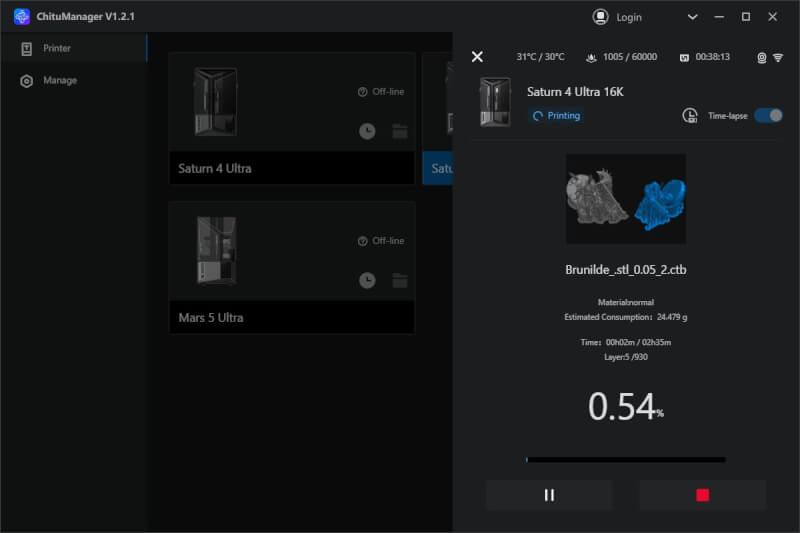
The biggest news in Chitubox is the possibility of network administration of the printer through the ChituManager extension that was included with the last generation of printers from Elegoo. Here it is possible to connect to the machine so that you can send the files directly from Chitubox to the internal memory of the machine. It is also possible to start printing directly from Chitubox.
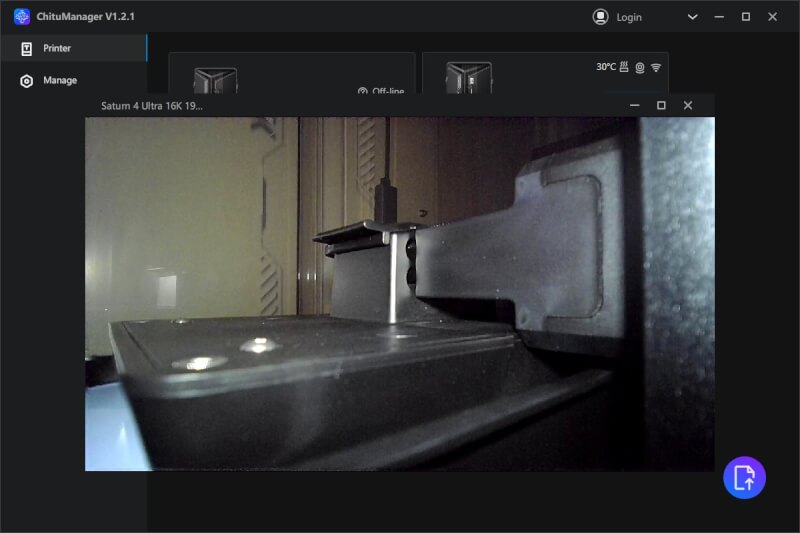
During the print process, it is possible to check the status via the ChituManager part of the software.
Test
As I always do with tests of 3D printers, I try to test it as much "out of the box" as possible. This was of course also the case here, where I simply unpacked the machine and collected the few parts that needed to be assembled and adjusted before I was ready to print.
The “Auto Level” feature made the process quite quick, and within 15 minutes I was ready to print. This also included a firmware update, which the machine did automatically when it connected to WiFi.
During my test, I used Elegoo's own Elegoo Standard Plant-based resin. So with that resin I printed the Chessboard test file that was on the included USB stick.
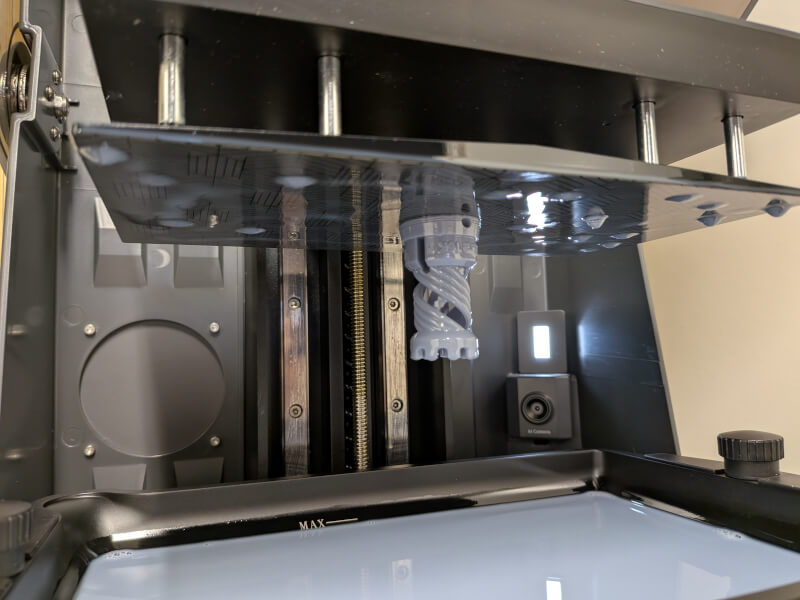
The machine handled that task without any problems and with a fine result. From here I started to do some tuning and tested the new exposure function. Here I managed to quickly test my way to a well-functioning exposure time of 1.8 seconds when printing with a layer height of 0.05 mm and 1.2 seconds at 0.02 mm.
As I said, I had the Pre-heating function turned on during all my prints. This of course means that the start-up can be a bit longer as you wait for things to heat up.
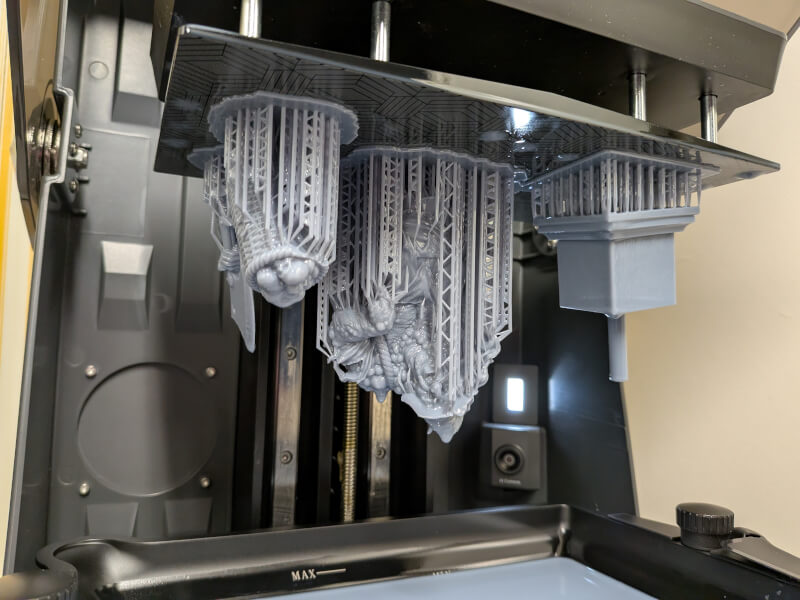 During the heating process, the machine lowers its build plate almost completely and moves it up and down quietly while heating. So not only does your resin heat up to 25 degrees, the machine also ensures that it is stirred, making the process faster and with a more uniform result.
During the heating process, the machine lowers its build plate almost completely and moves it up and down quietly while heating. So not only does your resin heat up to 25 degrees, the machine also ensures that it is stirred, making the process faster and with a more uniform result.
It has become a significantly easier process to slice files with the Saturn 4 Ultra 16K, as some of the variables you can normally set, such as lift height, lift speed, etc., are no longer relevant variables with the Tilt Release system.
After testing the included file, I threw myself into a selection of other files from Artisans Guild and Loot Studios, among others.
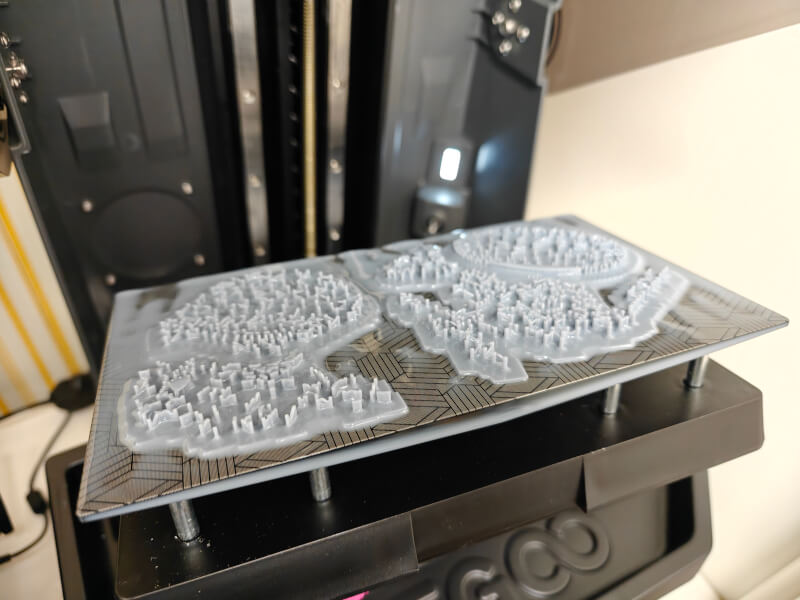 In almost all cases, the printing process went very quickly and without any problems. I once experienced an error where it seemed like the machine had stopped in the middle of the print. I restarted the machine and sliced the file again in Chitubox and did not experience any problems again.
In almost all cases, the printing process went very quickly and without any problems. I once experienced an error where it seemed like the machine had stopped in the middle of the print. I restarted the machine and sliced the file again in Chitubox and did not experience any problems again.
I can't say whether the error is due to the Saturn 4 Ultra 16K machine or a bug in the software, but it was the only error I experienced during my test.
Looking at the results of my test prints, I am super satisfied. The Elegoo Saturn 4 Ultra 16K prints quickly and produces sharp and detailed prints even down to the smallest details.
Price
Elegoo has listed the price of the Elegoo Saturn 4 Ultra 16K from their own EU webstore at 499€. So comparable to the original Saturn 4 Ultra when it was launched. Currently, there are offers on the original Saturn 4 Ultra, so it lands at just under 230€. So the jump up to the 16K version with the new features is about 80€.
However, Elegoo still undercuts other brands on the market with heated resin tanks, such as Uniformation or Anycubic.
Conclusion
I was super happy with my time with the Elegoo Saturn 4 Ultra, which delivered super great innovative features and beautiful prints.
With the Saturn 4 Ultra 16K, Elegoo has created an even better machine, which comes with both large and small updates that improve both usability and functionality.
I was a bit skeptical about the Tilt Release system when Elegoo introduced it on their latest generation of printers. However, I have now printed several hundred hours with the system on the Mars 5 Ultra, Saturn 4 Ultra and now the Saturn 4 Ultra 16K machines, and have not experienced any problems with the system.
During my testing period, I have experienced largely problem-free printing, with a high degree of user-friendliness and, not least, the quality of the finished prints.
The updates that Elegoo has made to the Saturn 4 Ultra 16K check off pretty much all the items on my wish list for a resin 3D Printer.
In my book, a heated tub in particular scores the most points, as it means you can now take another variable out of the equation when tuning your settings. At the same time, Elegoo has created a simple solution compared to, for example, Anycubic's solution.
On top of that, Elegoo has delivered it all at the same price as when they launched the Saturn 4 Ultra series.
I honestly can't find much to complain about after my time with the Elegoo Saturn 4 Ultra 16K. I know some people are fed up with the slightly unusual design of the machine's build plate, but personally it's not an issue here. It's more difficult to clean if you need to, but in my normal workflow it's so rare that I can't get upset about it.
A flatter and more compact design, such as on the Uniformation GK2 and GK3, would have been a nice bonus, but these are, after all, machines that are considerably more expensive.
The price is of course on the high side, but the combination of large build volume, good features, network, better camera and heated resin tank costs money, but at the same time makes it by far the best resin 3D Printer I have tried to date.
Elegoo still manages to do it at a price that is considerably lower than the Uniformation machines, which cost a lot more with many of the same features.
We end up with a final score of 10 and a Great Product Award, for a super solid Resin 3D Printer with a feature list that meets all my wishes for a Resin 3D Printer, and which delivers super good prints easily and quickly.
Benefits
- Heated resin tub
- Updated camera
- Fast prints
- More streamlined design
Disadvantages
- Nothing noteworthy

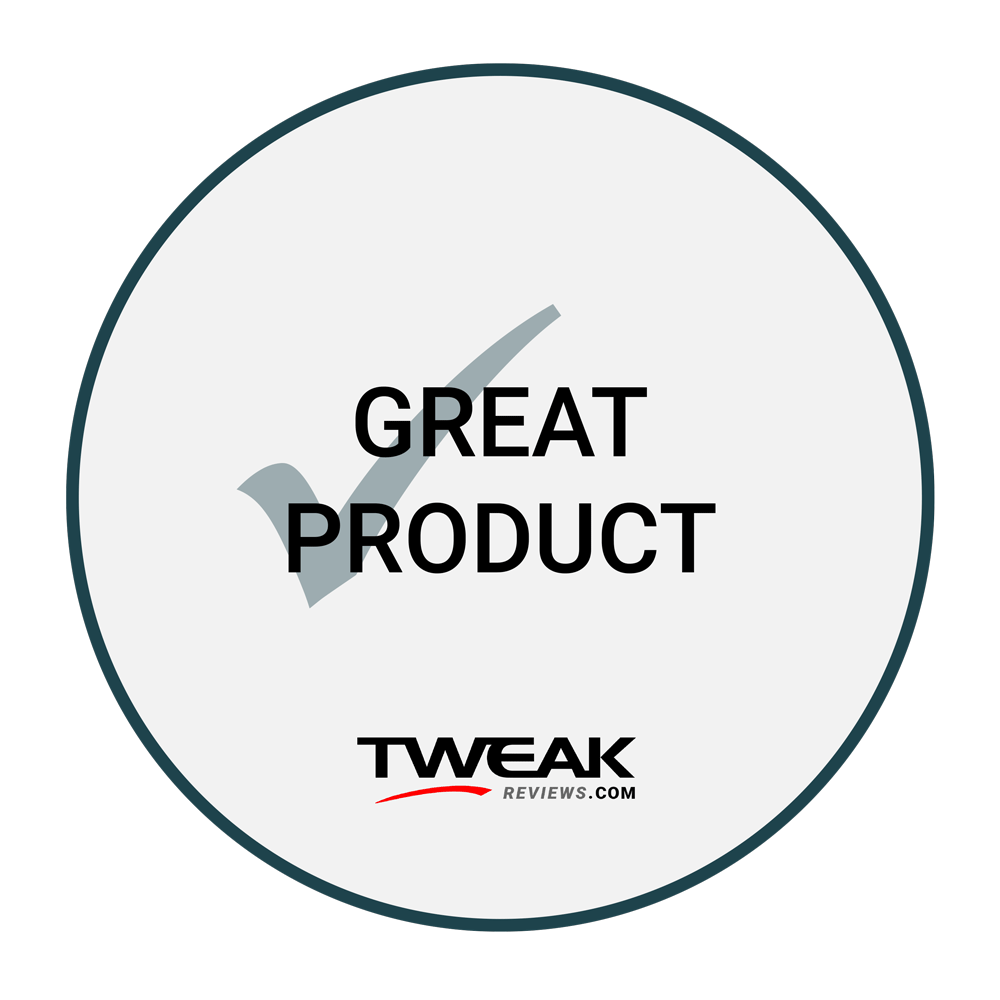
Latest printer
-
25 Junprinter
-
20 Junprinter
Bambu Lab Store turns three years old
-
25 Marprinter
Bambu Lab launches H2D
-
03 Marprinter
The world's first flying 3D printer
-
14 Febprinter
BIQU Panda BuildPlate CryoGrip
-
22 Janprinter
Elegoo Saturn 4 Ultra 16K
-
20 Janprinter
Bambu Lab security update
-
19 Novprinter
Prusa presents the Prusa CORE One
Most read printer
Latest printer
-
25 Junprinter
Elegoo launches reinforced filament
-
20 Junprinter
Bambu Lab Store turns three years old
-
25 Marprinter
Bambu Lab launches H2D
-
03 Marprinter
The world's first flying 3D printer
-
14 Febprinter
BIQU Panda BuildPlate CryoGrip
-
22 Janprinter
Elegoo Saturn 4 Ultra 16K
-
20 Janprinter
Bambu Lab security update
-
19 Novprinter
Prusa presents the Prusa CORE One






